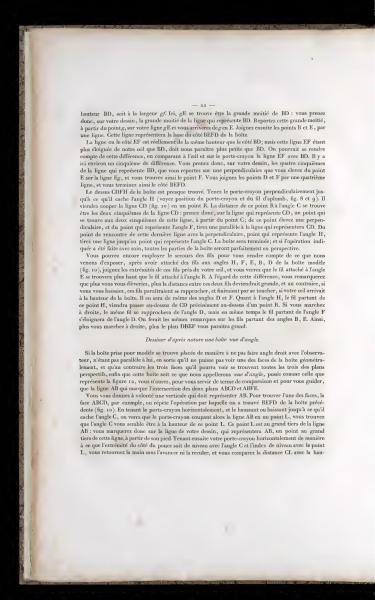- 22 -
Height BD is to width gf. Here, gf happens to be the larger half of BD: so on your drawing, you take the large half of the line representing BD. Transfer this large half from point g on your line gE and arrive at E. Then connect points D and E with a line. This line will represent the base of the BEFD side of the box.
The line CD on side EF is actually the same height as side BD, but this EF line being further from our eye than BD must appear smaller than BD. This difference can be perceived by comparing EF and BD to the eye and on the pencil holder. Here, there’s about a fifth of a difference. You take, therefore, four-fifths of the line representing BD and project it onto a perpendicular from point E on the line Eg; thus you find point F. Connect points D and F with a fourth line, thus completing side BEFD.
The top CDFH of the box is nearly found. Hold the pencil holder perpendicular until it hides angle H (refer to the pencil holder and plumb line positions in fig. 8 and 9). It will intersect line CD (Fig. 10) at point R. The distance from point R to angle gE is two-fifths of line CD: so take a point two-fifths from point C on the line representing CD; this point raises a perpendicular, and from the point representing angle F, draw a parallel to the line representing CD. From the intersection of this last line with the perpendicular, take that point representing angle H, draw a line to the point representing angle C. The box will be completed: and if the operation indicates care has been taken, all parts of the box will be perfectly in perspective.
You can also use thread to verify what we've just explained, after attaching threads to angles H, F, E, B, D of the model box (fig. 10), connect the ends of these threads near your eye, and you will see the thread attached to angle E is higher than the thread attached to angle B. To this difference, you’ll notice that the higher you go, the greater the distance between these two threads becomes, and conversely, the closer these threads appear if you lower yourself, eventually touching if your eye reaches the height of the box. It's the same for angles D and F. As for angle H, the thread from point H will pass above CD precisely above a point R. If you walk to the right, the same thread will approach angle D, but at the same time the thread from angle F will move away from angle D. You would make the same observations with the threads starting from angles B, E, thus, the more you walk to the right, the larger the DBEF plane will appear to you.
Drawing from nature a box seen from an angle.
If the box model is placed so that it does not form a right angle with the observer, not being parallel to them, resulting in them not seeing one face of the box geometrically, and contrary to that, seeing all three faces in perspective, lastly, this box being what we will call an angled view, positioned like the one shown in figure 12, you will only have the line AB marking the intersection of the two planes ABCD and ABFE to guide and compare.
You give yourself a vertical line to represent AB at will. To find one of the faces, face ABCD, for example, repeat the operation by which we found BEFD of the previous box (fig. 10). Holding the pencil holder horizontally, and lifting or lowering it until it hides angle G, you see the pencil holder then cuts the line AB at a point L, you find angle G seems to be at the height of this point L. This point L is a major third of line AB: so you mark on your drawing’s line, which will represent AB, a point at a major third from its foot. Then positioning your pencil holder horizontally so that the thumb-side tip is level with angle C and the index is level with point L, you rotate the hand without advancing or retreating, and compare the distance CL with the height.
Translation Notes
- Porte-crayon: a tool used historically to hold pencils for precision in drawing.
- Ligne de perspective: lines often used in art to denote depth.
